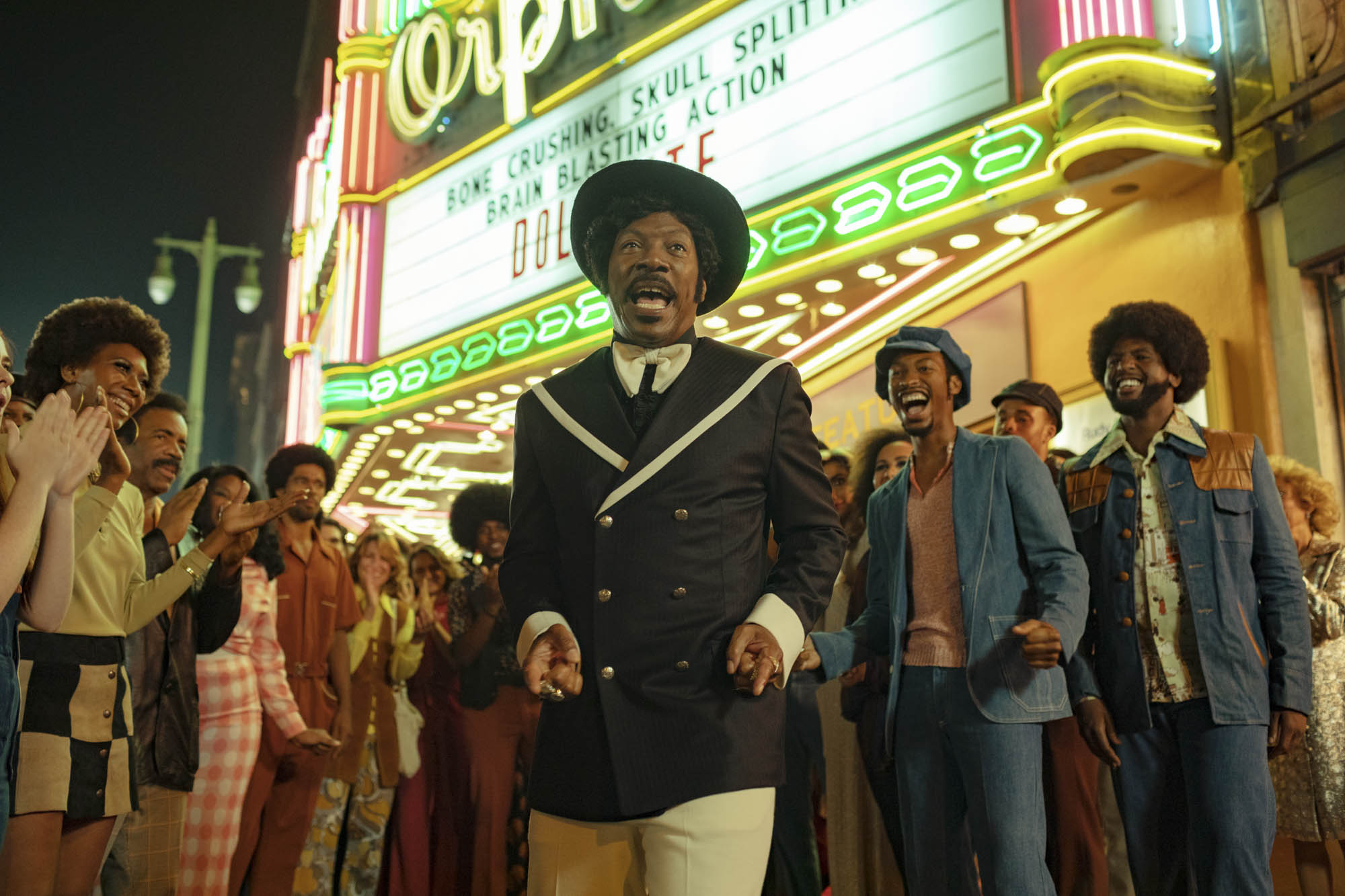Academy Museum Collections
Signs and Meaning: DOLEMITE IS MY NAME and the Dunbar Hotel
A recreation of the Dunbar Hotel sign, a recent acquisition to the Academy Museum’s collection, illuminates the long and eventful history of one of Los Angeles’s most important landmarks.

Eddie Murphey as Dolemite in Dolemite is My Name (2019), courtesy of François Duhamel/NETFLIX.
Dolemite Is My Name (2019) is perhaps most well-known for Eddie Murphy’s exuberant portrayal of real-life comedian, singer, filmmaker, and actor Rudy Ray Moore. The film was something of a comeback role for Murphy, but Dolemite is far more than an Eddie Murphy vehicle; it's a love letter to 1970s Los Angeles, which is recreated in sumptuous detail through the production design of Clay A. Griffith and his team, as well as through stunning period costumes by Ruth E. Carter.
 The Dunbar Hotel sign recreated for Dolemite Is My Name (2019), which is now part of the Academy Museum Collection, gift of NETFLIX, photo courtesy of Clay A. Griffith.
The Dunbar Hotel sign recreated for Dolemite Is My Name (2019), which is now part of the Academy Museum Collection, gift of NETFLIX, photo courtesy of Clay A. Griffith.
The beating heart of the film is the Dunbar Hotel, one of Los Angeles’s most important historical landmarks. We first encounter the Dunbar as a derelict building when Rudy (Murphy) goes in search of Ricco (Ron Cephas Jones), a man living on the street who is a self-proclaimed “repository of African-American folklore.” Ricco’s smart and foul-mouthed street poetry about a character called Dolemite had caught Rudy’s ear.
Brandishing some hooch, a wad of dollar bills, and a tape recorder, Rudy sits and records Ricco and his friends attempting to outdo each other with their rhymes. Gathered around a fire in the alley at the side of the hotel, they point out the Dunbar’s decaying sign and tell Rudy about the hotel's former life as Los Angeles’s “center of Black arts entertainment,” home to performers such as Duke Ellington and Billie Holiday but now inhabited by “junkies and winos.” The Dunbar soon makes its own comeback of sorts, however. Rudy moves in, using it as the production base for a movie starring himself in his hugely successful, self-created pimp persona: Dolemite.
 The Dunbar Hotel, ca. 1938, courtesy of Thomas Safran Associates, Coalition for Responsible Community Development.
The Dunbar Hotel, ca. 1938, courtesy of Thomas Safran Associates, Coalition for Responsible Community Development.The Somervilles were successful dentists and respected Black intellectuals active in the National Association for the Advancement of Colored People (NAACP). They created the hotel to provide quality accommodations for Black people in then-segregated Los Angeles. The hotel quickly became a hub for African-American political and cultural life and, in its inaugural year, hosted the first NAACP West Coast convention. Many prominent Black guests would pass through its doors over the subsequent decades, from civil rights activists to artists, actors, athletes, and musicians, including Duke Ellington, Billie Holiday, W. E. B. Du Bois, Langston Hughes, Lena Horne, Ella Fitzgerald, Bill “Bojangles” Robinson, and Sammy Davis Jr.
Given this history, the Dunbar Hotel was a location laden with meaning and significance to the contemporary filmmakers behind Dolemite is My Name. In a recent conversation, production designer Clay Griffith told the Academy Museum that it served as a “north star” during pre-production: “It all started at the Dunbar.” This was quite literally true as the hotel was the first stop for location research. While the hotel survived some tempestuous decades and has now happily found new life as a residence for seniors, the building’s new function made it unsuitable for use in the movie. Nonetheless, the archival photos that line the senior home’s walls as well as the building’s famous neon-lit sign were key to developing the look and spirit of the hotel for the film. Interiors were recreated in the studio, and after much searching, Griffith and location manager David Lyons discovered the Royal Lake apartments in Pico-Union to stand in for the hotel’s exterior.
 Art Department production drawing for the Dunbar sign, including a location research photograph, courtesy of NETFLIX.
Art Department production drawing for the Dunbar sign, including a location research photograph, courtesy of NETFLIX. The sign being installed on the Royal Lake apartments, courtesy of Clay A. Griffith.
The sign being installed on the Royal Lake apartments, courtesy of Clay A. Griffith. The Hotel Dunbar’s sign comes back to life in Dolemite is My Name (2019), courtesy of NETFLIX.
The Hotel Dunbar’s sign comes back to life in Dolemite is My Name (2019), courtesy of NETFLIX.The Hotel Dunbar sign is on view at the Academy Museum from February 1 – July 9, 2023.